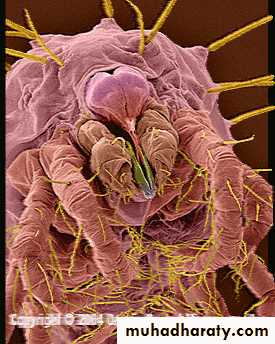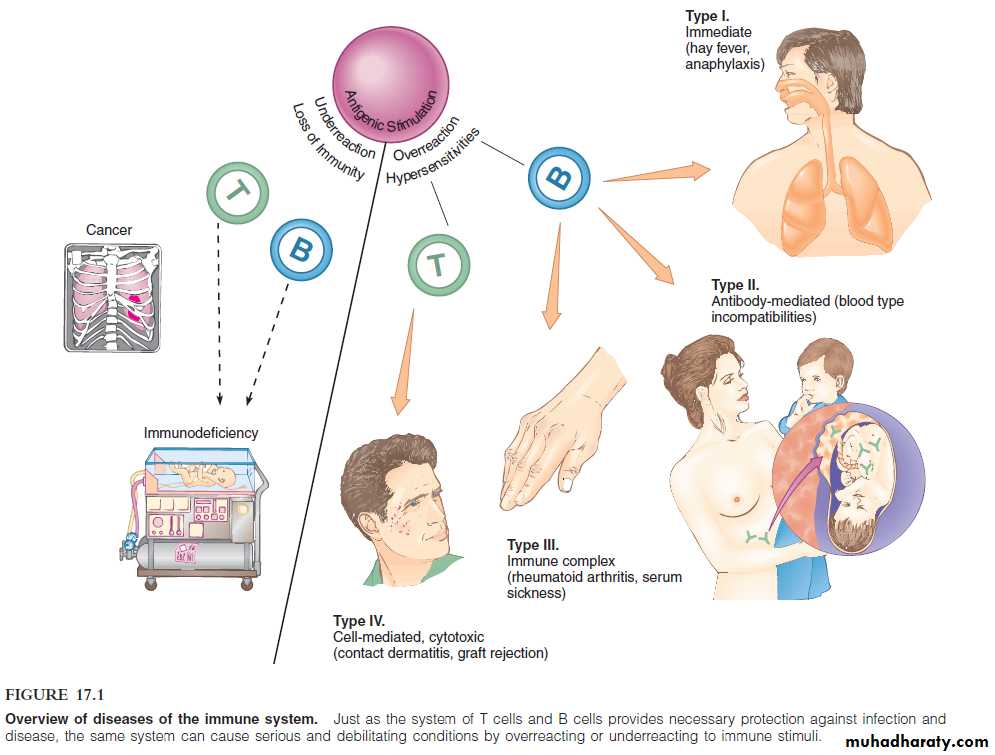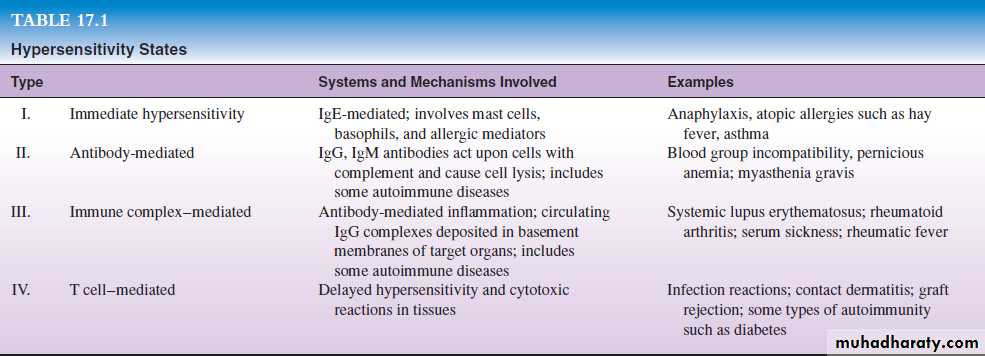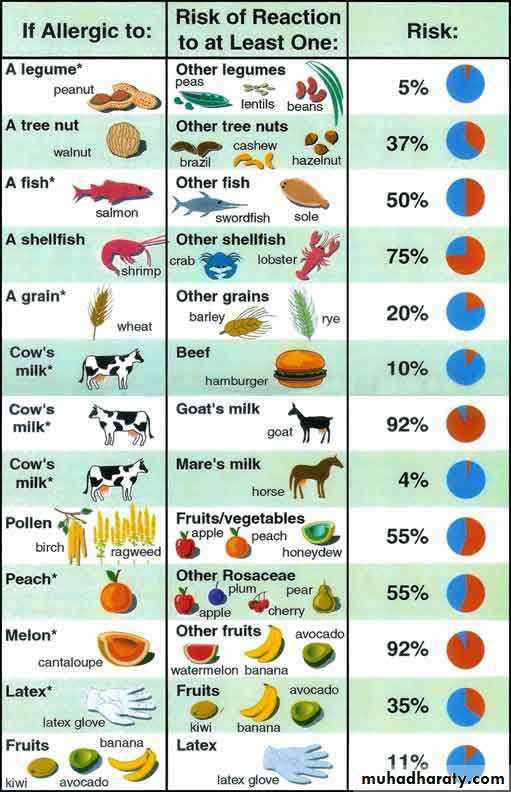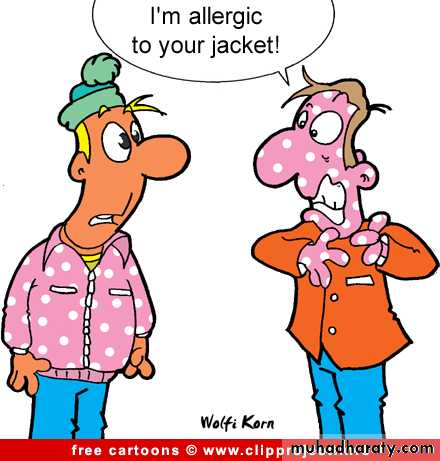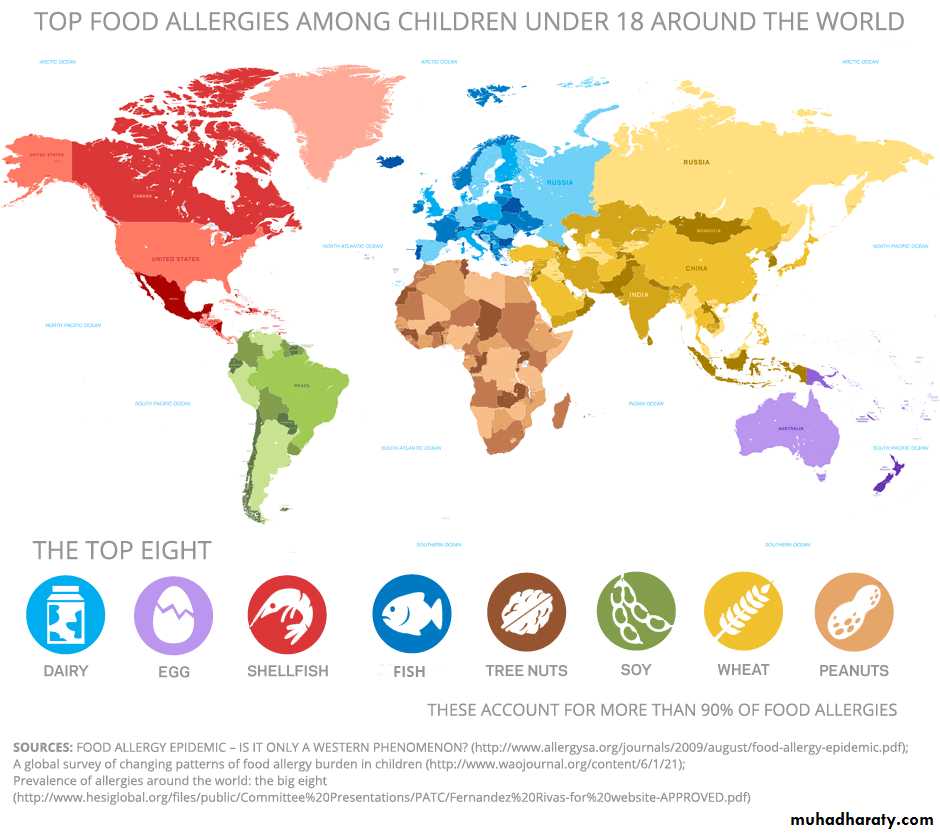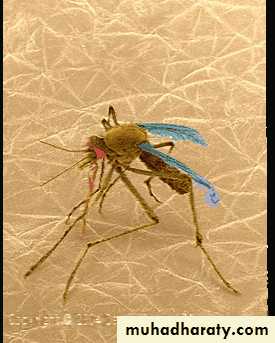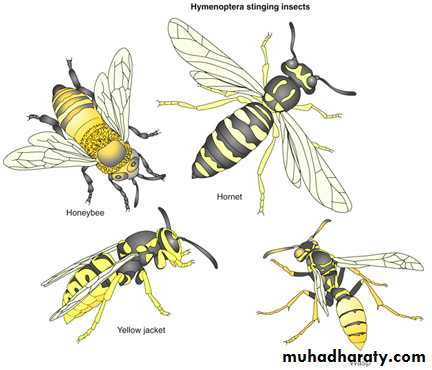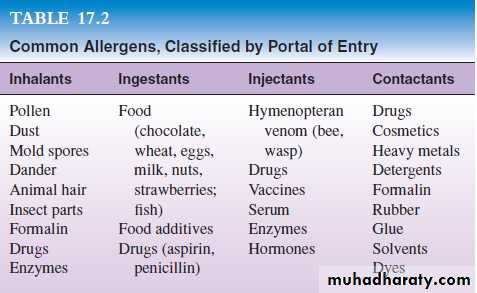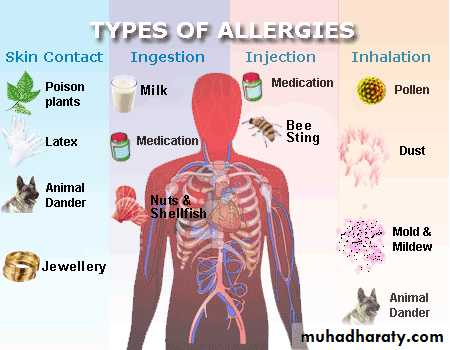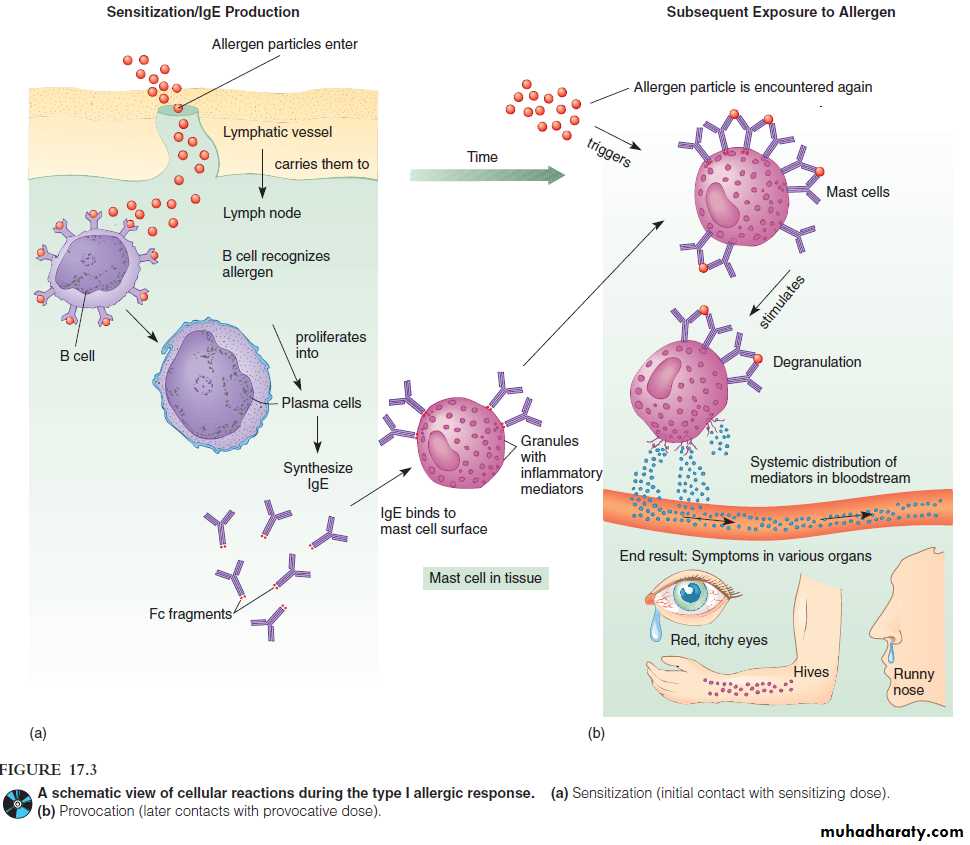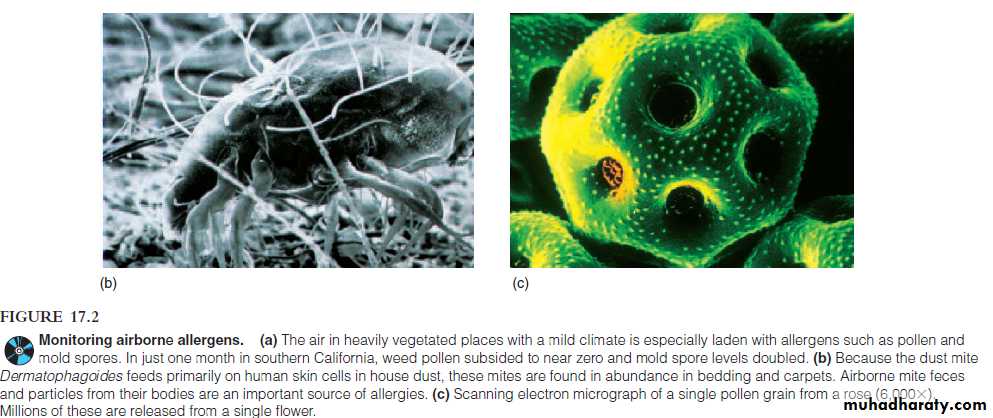Disorders in Immunity 1
Talib Hassan
11th lecture
1
The Immune Response: A Two-Sided Coin
The precisely coordinated system that recognizes, and destroys an unending array of foreign materials is clearly protective, but it also presents another side (a side that promotes rather than prevents disease).Immunopathology: the study of disease states associated with over-reactivity or under-reactivity of the immune response .
In allergies and autoimmunity, the tissues are innocent bystanders attacked by excessive immunologic functions.
In grafts and transfusions, a recipient reacts to the foreign tissues and cells of another individual.
In immunodeficiency diseases, immune function is incompletely
developed, suppressed, or destroyed.
Cancer falls into a special category, because it is both a cause and an effect of immune dysfunction.
11th lecture
2
3
11th lecture
4Overreactions to Antigens:Allergy/Hypersensitivity
Allergy : a condition of altered reactivity or exaggerated immune response that is manifested by inflammation.Some experts refer to immediate reactions such as hay fever as allergies and to delayed reactions as hypersensitivities. Allergic individuals are acutely sensitive to repeated contact with antigens, called allergens, that do not noticeably affect non-allergic individuals.
The general effects of hyperactivity are very same types of immune reactions as those at work in protective immunities. These include humoral and CMI, the inflammatory response, phagocytosis, and complement.
11th lecture
5
Hyper sensitivity classification includes four major categories:
type I (atopy and anaphylaxis),
type II (IgG- and IgM-mediated cell damage),
type III (immune complex),
type IV (delayed hypersensitivity)
In general, types I, II, and III involve B-cell–immunoglobulin response, and type IV involves a T-cell response
The antigens that elicit these reactions can be exogenous, originating from outside the body (microbes, pollen grains, and foreign cells and proteins), or endogenous, arising from self tissue (autoimmunities).
One of the reasons allergies are easily mistaken for infections is that both involve damage and signs of inflammation (redness, heat, skin eruptions, edema, and granuloma) are prominent features of allergies.
11th lecture
6
Type I Allergic Reactions:
All type I allergies (Atopy and Anaphylaxis) share a similar physiological mechanism, are immediate in onset, and are associated with exposure to specific antigens.
However, it is recognize as two subtypes:
Atopy: is any chronic local allergy such as hay fever or asthma.
Anaphylaxis: is a systemic, often explosive reaction that involves airway obstruction and circulatory collapse.
11th lecture
7
EPIDEMIOLOGY AND MODES OF CONTACT WITH ALLERGENS
About 10-30% of the population is prone to atopic allergy.The majority of type I allergies are relatively mild, but certain forms such as asthma and anaphylaxis may require hospitalization and cause death.
The predisposition for type I allergies is inherited.
Be aware that what is hereditary is a generalized susceptibility, not the allergy to a specific substance (a parent who is allergic to ragweed pollen can have a child who is allergic to cat hair)
11th lecture
8
9
10
THE NATURE OF ALLERGENS AND THEIR PORTALS OF ENTRY
Some allergens are haptensAllergens typically enter through epithelial portals in the respiratory tract, gastrointestinal tract, and skin. The mucosal surfaces of the gut and respiratory system present a thin, moist surface that is normally quite penetrable.
The dry, tough keratin coating of skin is less permeable, but access still occurs through tiny breaks, glands, and hair follicles.
11th lecture
11The allergens classified by the portal of entry into:
Inhalants: airborne environmental allergens (pollen, house dust, or fungal spores).Pollen, the most common offender, is given off seasonally by the reproductive structures of pines and flowering plants.
Unlike pollen, mold spores are released throughout the year and are especially profuse in moist areas of the home and garden.
Airborne animal hair and dander, feathers, and the saliva of dogs and cats are common sources of allergens.
Some people are allergic to their work, on the job (florists, beauty operators, woodworkers, farmers, drug processors, welders, and plastics manufacturers) whose work can aggravate inhalant allergies.
12
11th lecture
Ingestants: allergens that enter by mouth, (food allergies)
Injectant: allergies are an important adverse side effect of drugs or other substances used in diagnosing, treating, or preventing disease.A natural source of injectants is venom from stings by hymenopterans, includes honeybees and wasps.
Contactants: are allergens that enter through the skin. Many contact allergies are of the type IV, delayed variety
13
11th lecture
11th lecture
14Mechanisms of Type I Allergy
In general, type I allergies develop in stages.The initial encounter with an allergen provides a sensitizing dose that primes the immune system for a subsequent encounter with that allergen but generally elicits no signs or symptoms.
The memory cells and immunoglobulin are then ready to react with a subsequent provocative dose of the same allergen, this dose that precipitates the signs and symptoms of allergy. Fetal exposure to allergens from the mother’s bloodstream is one possibility, and foods can be a prime source of “hidden” allergens such as penicillin.
15
11th lecture
16
11th lecture
17The Physiology of IgE-Mediated Allergies
When large particles such as pollen grains, hair, and spores encounter a moist membrane, they release molecules of allergen that pass into the tissue fluids and lymphatics.The lymphatics then carry the allergen to the lymph nodes, where specific clones of B cells recognize it, are activated, and proliferate into plasma cells.
These plasma cells produce immunoglobulin E (IgE), the antibody of allergy.
IgE is different from other immunoglobulins in having an Fc receptor region with great affinity for mast cells and basophils.
18
11th lecture
The Role of Mast Cells and Basophils
The most important characteristics of mast cells and basophils relating to their roles in allergy are:
• Mast cells are high concentrated in the lungs, skin, gastrointestinal tract, and genitourinary tract.
Basophils circulate in the blood but migrate readily into tissues.
• Their capacity to bind IgE during sensitization. Each cell carries 30,000 to 100,000 cell receptors that attract 10,000 to 40,000 IgE antibodies.
• Their cytoplasmic granules (secretory vesicles), which contain physiologically active cytokines.
• Their tendency to degranulate, or release the contents of the granules into the tissues when properly stimulated by allergen.
19
11th lecture
The Second Contact with Allergen
After sensitization, a person can retain the capacity to react immediately upon reexposure. The next time allergen molecules contact these sensitized cells, they bind across adjacent receptors and stimulate degranulation. As chemical mediators are released, they diffuse into the tissues and bloodstream. Cytokines give rise to numerous local and systemic reactions, many of which appear quite rapidly.The symptoms of allergy are not caused by the direct action of allergen on tissues but by the physiological effects of mast cell mediators on target organs.
20
11th lecture



